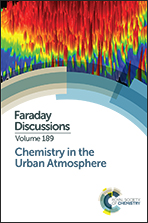Twenty years of ambient observations of nitrogen oxides and specified hydrocarbons in air masses dominated by traffic emissions in Germany
Abstract
The analysis of the individual composition of hydrocarbon (VOC) mixtures enables us to transform observed VOC-concentrations into their respective total VOC-reactivity versus OH radicals (RVOC = Σ(kOH+VOCi × [VOCi])). This is particularly useful because local ozone production essentially depends on this single parameter rather than on the details of the underlying hydrocarbon mixture (Klemp et al., Schriften des Forschungszentrums Jülich, Energy & Environment, 2012, 21). The VOC composition also enables us to pin down the major emission source of hydrocarbons in urban areas to be petrol cars with temporarily reduced catalyst efficiency (the so-called cold-start situation) whereas the source of nitrogen oxides (NOx = NO + NO2) is expected to be nowadays dominated by diesel cars. The observations in the vicinity of main roads in German cities show a decrease in the ratio of OH reactivities of VOC and NO2 (RVOC/RNO2) by a factor of 7.5 over the time period 1994–2014. This is larger than the expected decrease of a factor of 2.9 taking estimated trends of VOC and NOx traffic emissions in Germany (Umweltbundesamt Deutschland, National Trend Tables for the German Atmospheric Emission Reporting, 2015), during this time period. The observed reduction in the RVOC/RNO2 ratio leads to a drastic decrease in local ozone production driven by the reduction in hydrocarbons. The analysis reveals that the overall reduction of ozone production benefits from the low decrease of NOx emissions from road traffic which is a consequence of the eventual absence of catalytic converters for nitrogen oxide removal in diesel cars up to now.
- This article is part of the themed collection: Chemistry in the Urban Atmosphere

 Please wait while we load your content...
Please wait while we load your content...